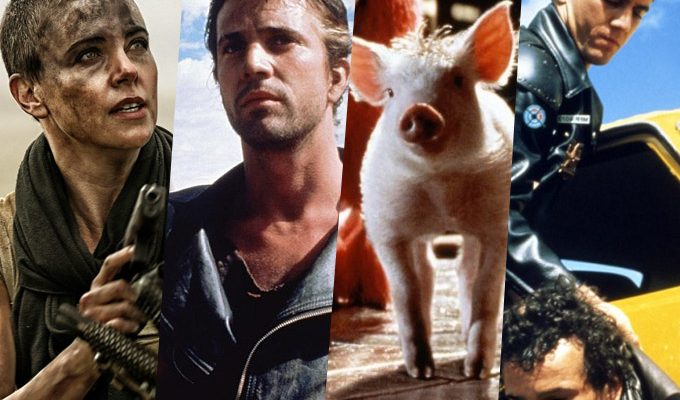
6. “Happy Feet” (2006)
Miller got the idea of setting a story in Antartica during the production of “Mad Max: The Road Warrior,” though it’s doubtful he imagined it would be computer-animated and arrive some 20 years later. “Happy Feet” is the story of Mumble (Elijah Wood), an emperor penguin who was dropped as an egg by his father Memphis (Hugh Jackman), and as a result developed a rare “deficiency:” unlike every other emperor penguin, Mumble can’t sing to save his life but has an innate talent for tap-dancing, earning him the nickname Happy Feet. Years later, Mumble is branded an outcast by the wise elder Noah (Hugo Weaving), and ridiculed for being a penguin who will likely never find a mate because he doesn’t have the gift of heartsong, even though he falls hard for the popular Gloria (Brittany Murphy). Were it in anyone else’s hands, “Happy Feet” would’ve probably stayed within the confines of animated Antarctica, focusing on PG-themes about one’s true worth and courage, but under Miller’s guidance, the story dives head first into environmental issues as well, taking Mumble on a journey that finds him washed ashore in Australia and communicating with live action humans (“aliens” in penguin language). Four years in the making, the glory of “Happy Feet’s” animation is most readily felt in the underwater scenes of choreographed jubilance between a rookery of penguins, or the close ups of Mumble’s crystalline-blue eyes, and the pleasure of the entire experience is amplified tenfold thanks to Robin Williams’ greatest voice performance since “Aladdin.” His Ramon and Lovelace, a couple of penguins who embrace Mumble’s weirdness, are the kind of supporting characters who effortlessly steal the spotlight scene after scene. While some songs overstay their welcome, the renditions of Queen‘s “Somebody To Love” and a Spanish version of “My Way,” as sung by Williams’ Ramon, (among others), are contagious highlights that celebrate everything every Miller antagonist (be they human, animal, animated or live-action) fights for and believes in. It’s one of the director’s most profitable directorial efforts to date and sees him at the peak of his PG powers.

5. “Mad Max: Beyond Thunderdome” (1985)
It’s got its defenders, but the third installment of Miller’s franchise goes the way of so many threequels; it’s glaringly less accomplished than its predecessors and a little too eccentric for its own good. “Mad Max: Beyond Thunderdome” famously features Tina Turner in the role of Aunty, the matriarch ruler of the grotesque Bartertown, and while it’s impossible to think of anyone who could replace her, it’s just as hard to admit she’s got any real acting chops (though she sure knows how to command attention). 15 years after the events of the second film, ‘Thunderdome’ sees Max (Mel Gibson) roaming through the desert and happening upon Bartertown, where he reluctantly agrees to assassinate the muscled half of the two people who make up “MasterBlaster;” a little person who is the brains of the underworld operations (“The Master,” played by Angelo Rossitto) piggy-backing on a mute giant (“The Blaster,” Paul Larsson). The fight between Blaster and Max in the Thunderdome is oddly incoherent; they are placed on giant slingshots and have to fight each other to the death by picking up weapons scattered around different parts of the dome-like structure. As weirdly out of place as it is, the moment Max refuses to finish Blaster off is a great summary of Miller’s philosophy of violence. Nevertheless, the film feels somewhat empty, especially in its second half when a whole subplot featuring a tribe of children is introduced. Miller’s producing partner Byron Kennedy passed away before production started, which explains why he got George Ogilvie to co-direct. Grieving and disinterested, Miller focused mostly on the action (which aside from the Thunderdome fight features an exhilarating train chase at the end) while Ogilvie was left with the rest, which was compromised by a bungled screenplay (“Bust a deal, face the wheel!”). It’s got that 80s B-movie relish which gives it an attractive nostalgic coating, but ‘Thunderdome’ is noticeably more deficient than the first two (and, from the sounds of it, the latest) installments in the series.

4. “Lorenzo’s Oil” (1992)
Ditching the fantasy milieu for his next project, Miller turned his attention to the medical phenomenon of adrenoleukodystrophy (ADL) in the early 90s, a horrendous disease that afflicts boys at a tender age and erodes the brain tissue in relentlessly rapid fashion until death. When Lorenzo Odone (Zach O’Malley Greenburg) is diagnosed with ADL, his parents Michaela (Susan Sarandon in an incredible Oscar-nominated turn) and Augusto (Nick Nolte with an incredulous Italian accent) are told that most ADL boys die within 24 months of diagnosis. “Lorenzo’s Oil” follows the true-life tale of these two headstrong parents on a quest to understand this disease and find a way to circumvent its merciless manifestation as current scientific treatments, like the diet prescribed by an ADL expert Dr. Gus Nikolais (Peter Ustinov), or risky immunosuppression techniques, aren’t helping. Far removed from the comedic fantasies of “The Witches of Eastwick” or the adrenaline-pumping action of the “Mad Max” movies, Miller reveals his most emotional and deeply dramatic side here. The vicious disease itself is Miller’s most dangerous antagonist, and the theme of a seemingly unstoppable force corrupting the innocent, the pure, and the kind is omnipresent. Like Daryl Van Horne or the reprobates who rule the dystopian Australian wastelands in the “Mad Max” movies, ADL consumes and disturbs the peace. Miller’s direction climbs the walls, especially in and around the Odone household; with short circuited conversations, expeditious editing, paranoid panning, tilted angles, and claustrophobically tight close up shots, Miller conveys the urgency and horror superbly. It’s a rare Miller film that doesn’t have much of a rewatch value because of how big of an emotional gut-punch it is, but it’s the most important story of human courage he’s ever told.

